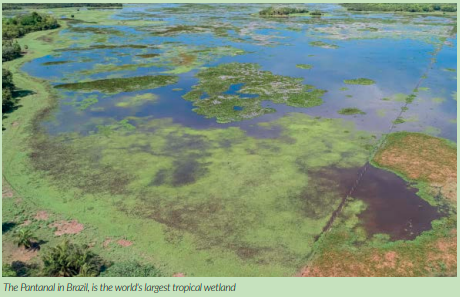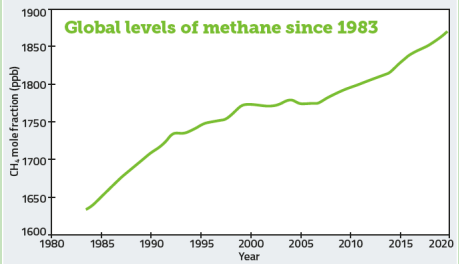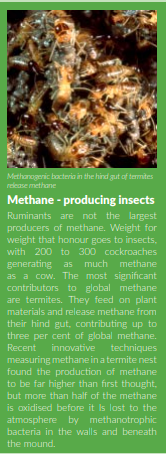Written by Sally Morgan who edits Organic Farming magazine smorgan@soilassociation.org
With ruminants getting bad press at the moment over their methane-filled belches, Sally Morgan looks at the science and the critical role of methane-eating microbes

Are ruminants really to blame for the rapid increase in methane levels over the last decade?
There is no denying methane is a significant contributor to climate change. Its global warming potential is said to be as much as 28 times that of carbon dioxide, but it has a much shorter life of around 12 years. The concern about methane is the sudden surge in levels since 2008. It came out of nowhere and scientists are still unsure of the cause. Current levels are just under 1,900 parts per billion, contributing an estimated 20 per cent of total atmospheric warming to date.

Commentators have been quick to put the blame on ruminants, a blame game that started back in 2006 when the UN Food and Agriculture Organisation published a study entitled Livestock’s Long Shadow. The study claimed that livestock production was responsible for 18 per cent of all greenhouse gas emissions (a figure which has since been revised down considerably). Since then, many organisations have called for a reduction in meat consumption and a switch away from extensive systems to intensive ones, in which animals are raised quickly on grain and soyabased diets that generate less methane. However, it’s becoming increasingly apparent that the methane story is far from clear cut.
Methane sources
There are various sources of methane, both natural and anthropogenic, with the latter being responsible for about 60 per cent of global methane emissions. Methane is released by microbes called methanogens during microbial decomposition of organic matter, especially that which takes place under water in anaerobic conditions as found in wetlands and paddy fields. It’s also released by microbes living in the gut, in particular, the rumen of ruminant mammals and the gut of insects, such as termites.
Methane is released during the decomposition of natural gas, the so-called geological methane, which is stored in underground reservoirs and reaches the surface via seepage, geothermal and hydrothermal activity etc, along with climate-active ethane and propane. Other sources include fossil fuel extraction, fracking, mining, landfill, waste management and the manufacture of nitrogen fertiliser (see Organic Farming 131, Summer 2019).
Interestingly, atmospheric methane levels did not rise between 1999 and 2006 despite a 70 per cent increase in livestock numbers and looking further back to times when vast herds of ruminants were grazing grasslands across the world, methane levels ranged between 350 and 750 ppb. So what’s caused the dramatic rise over the last 12 years? There’s much finger-pointing. Some put the blame on leaks from gas fields, while recent research from Cornell University puts the blame on the boom in the US shale gas and oil industry. Discovering that the chemical fingerprint of methane from fracking differs from that released by traditional fossil fuels and livestock, researchers were able to track the source. They claim that as much as a third of recent methane emissions may come from shale gas development. However, others suggest that tropical wetlands are the only source large enough to explain the sudden rise.
Methanotrophs
It’s not just methane sources that are important; we need to know how much methane is oxidised to carbon oxide and water. This happens naturally in the lower atmosphere but there’s another methane sink of interest, a group of microorganisms called methanotrophs. These are single-celled organisms, such as bacteria, that consume methane as their source of carbon. They can be aerobic or anaerobic and are usually obligate, which means that methane is their only carbon source, so they are particularly common in places where methane is produced. Without them levels of methane would be much higher. In fact, half the methane released by wetlands may be taken up by methanotrophs and oxidised (Dunfield, 2007).
Boosting methanotrophs
Little is known about the soil-living methanotrophs. We know they are found in a range of soils and survive on low levels of methane and that soil management affects their numbers. In conventionally managed soil, the continued application of inorganic nitrogen fertiliser reduces the capacity of soil to oxidise methane and this is linked to reduced numbers of methanotrophs, whereas organic sources of nitrogen, such as manure, enhance the ability of soil to oxidise methane (Brady, 2002). Tillage and other soil disturbance will also adversely affect their populations, reducing numbers by as much as 80 per cent (Evershed, 2012). So, to boost methane oxidation, soils must be well aerated, and tillage and the use of inorganic nitrogen sources avoided. Also, research on alpine meadow soil found one group of methanotrophs to be strongly boosted by the grazing of cattle (Abell et al, 2015).
Livestock emissions
Ruminant emissions vary, even within species. Cattle, for example, produce between 164 and 345 mg of methane per day, with cattle on high-fibre feed producing more methane than those on a grain-based diet. But, as always, the whole picture has to be considered. Grain-fed beef animals may emit less methane, but overall, the energy required to finish these animals is twice that of pasture-fed, because of the use of fossil fuels in growing, harvesting and transporting grain, with additional greenhouse gas emissions from the manufacture and transport of nitrogen fertilisers etc. So, when looking at the lifecycle, it’s important to offset any methane production with sequestering gains; a well-managed, rotationally grazed permanent pasture will sequester carbon, so helping to offset methane production by the animals.

Plenty of lab-based studies have measured methane in a cow’s burp, but this takes no account of its lifestyle. When they are on pasture, head down and grazing, a burp of methane soon gets mopped up by methantrophs living in the soil. If you have a well-managed pasture with a soil rich in microorganisms, methane is not so much of a problem. But place them in unnatural situations, such as vast feedlot in the US or on a poorly managed pasture in the UK that is regularly fertilised, you disrupt the system and the soil will be less able to deal with methane.
Simply tweaking the diet can result in fewer methane emissions: for example, the feeding of sainfoin silage, adding more oil or seaweed. Biochar, too, may have potential. Research shows that biochar can increase the ratio of methanotrophs to methanogens in paddy fields and a similar process may occur in the rumen
Intensive systems
Many overlook the role of intensive livestock operations. Animal waste from intensively raised pigs and large dairy operations is typically stored in lagoons and slurry holding tanks, where the anaerobic decomposition of the organic material produces methane (as well as nitrous oxide which has almost 300 times the GWP of carbon dioxide). This can be avoided if the slurry is fed into an anaerobic digester and the methane captured, or the manure is spread on to heathy soil where dung beetles, earthworms and other soil life can pull it into the soil to be worked on by decomposers and the carbon locked up. Under these systems there will be no significant methane production (FAO, 2002).
There is no easy answer to the livestock question. I don’t think anybody wants a shift to highly intensive systems with all the welfare issues that would result, but without livestock, we’d need more plant crops and they require nitrogen. A lack of manures would mean more land under fertility-building leys or more inorganic nitrogen fertiliser which has a major role in the methane story. It’s a complex situation, whatever food type is producer, there are methane implications.

